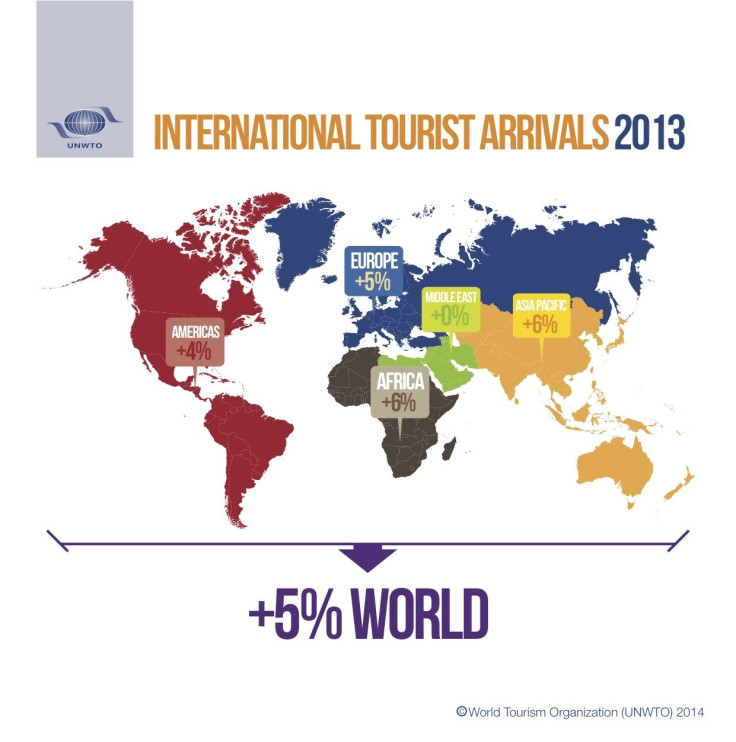Tourism In 2013: Where Did It Grow And Who Fueled That Growth?

If your trip to the airport, train station or international border last year was even more frazzling than usual, here are some statistics that may explain why: An additional 52 million international tourists traveled the world in 2013, setting a new record of 1.087 billion arrivals, according to the latest statistics from the U.N. World Tourism Organization.
Even by the UNWTO’s own predictions, that figure well exceeded expectations. “2013 was an excellent year for international tourism,” UNWTO Secretary-General Taleb Rifai boasted Monday. “The tourism sector has shown a remarkable capacity to adjust to the changing market conditions, fueling growth and job creation around the world, despite the lingering economic and geopolitical challenges. Indeed, tourism has been among the few sectors generating positive news for many economies.”
UNWTO forecasts international arrivals to increase by another 4 to 4.5 percent in 2014. While down slightly from the 5 percent growth in 2013, that figure is still above the long-term forecast of 3.8 percent growth between 2010 and 2020.
“The positive results of 2013, and the expected global economic improvement in 2014, set the scene for another positive year for international tourism,” Rifai noted. “Against this backdrop, the UNWTO calls upon national governments to increasingly set up national strategies that support the sector and deliver on their commitment to fair and sustainable growth.”
Tourism Growth By Region
Demand for international tourism last year was strongest for destinations in Asia-Pacific (up 6 percent), Africa (up 6 percent) and Europe (up 5 percent). More specifically, Southeast Asia (up 10 percent), Central and Eastern Europe (up 7 percent), South and Mediterranean Europe (up 6 percent), and North Africa (up 6 percent) saw the greatest growth.
Europe once again led growth in terms of the sheer number of visitors, welcoming an additional 29 million international tourists in 2013 to raise its total number of arrivals to 563 million. Its growth of 5 percent far exceeded expectations and was double the region’s seven-year average.
Relative growth, meanwhile, was strongest in Asia and the Pacific where strong gains in Southeast Asia brought the number of international tourists up 14 million to a total of 248 million. By comparison South Asia (up 5 percent), Northeast Asia (up 4 percent) and Oceania (up 4 percent) saw modest gains.
Growth in the Americas, too, was relatively modest last year at 4 percent. The region saw an increase of 6 million tourists to reach a total of 169 million arrivals. North and Central America led the way with gains of 4 percent, while South America (up 2 percent) and the Caribbean (up 1 percent) lagged behind.
The Middle East saw absolutely no growth, while North Africa (up 6 percent) and Sub-Saharan Africa (up 5 percent) took Africa to a new record of 56 million arrivals.
Looking forward to 2014, UNWTO once again expects prospects to be strongest in Asia (5-6 percent growth) and Africa (4-6 percent growth), followed by Europe and the Americas (both 3-4 percent growth).
Top Outbound Markets
Two nations in particular have emerged as the driving force behind the worldwide surge in tourist arrivals: Russia and China. China, which became the largest outbound market in 2012 with an expenditure of $102 billion, saw an increase in expenditure of 28 percent in the first three quarters of 2013. Russia, meanwhile, is now the fifth-largest outbound market with 26 percent growth through September.
Elsewhere, growth in outbound expenditure was up 24 percent in Turkey and 18 percent in both the Philippines and Qatar. Kuwait, Indonesia, Ukraine and Brazil also saw substantial growth in outbound expenditure in 2013.
By comparison, advanced economies saw more modest changes, though France recovered from a weak 2012 with 6 percent growth. Outbound expenditure grew at 3 percent for the U.S., U.K, Canada and Australia, while Germany, Japan and Italy all reported declines.
Fastest-Growing Destinations
The list of the world’s most visited countries remained relatively unchanged in 2013, with France, the U.S. and China once again atop most itineraries. What did change, however, was global interest in several other nations.
Japan reported staggering growth in international tourist arrivals of 24 percent last year, thanks in no small part to a weakened yen and a post-tsunami tourism push. Elsewhere in Asia, Thailand managed to nab 19.6 percent more tourists last year (despite growing political uncertainty), while Taiwan (up 9.7 percent), Vietnam (up 10.6 percent) and Philippines (up 11.2 percent) also fared exceptionally well.
Kazakhstan was, perhaps, the biggest surprise of 2013 with 21.9 percent growth in international tourist arrivals. Its proximity to both China and Russia no doubt helped the oft-overlooked Central Asian nation grow its burgeoning tourism industry.
Rounding out the top 10 fastest growing tourism destinations of 2013 were Greece (up 15.5 percent), Turkey (up 10.5 percent), Russia (up 10.5 percent) and the UAE (up 10.4 percent).
© Copyright IBTimes 2024. All rights reserved.






















